Information
LHCb-PAPER-2013-013
CERN-PH-EP-2013-083
arXiv:1305.5059 [PDF]
(Submitted on 22 May 2013)
Phys. Lett. B725 (2013) 16
Inspire 1235028
Tools
Abstract
A search for the rare decay $D^0 \to \mu^+ \mu^-$is performed using a data sample, corresponding to an integrated luminosity of 0.9 fb$^{-1}$, of $pp$ collisions collected at a centre-of-mass energy of 7 TeV by the LHCb experiment. The observed number of events is consistent with the background expectations and corresponds to an upper limit of ${\cal B}(D^0 \to \mu^+ \mu^-) < 6.2(7.6) \times 10^{-9}$ at 90 (95) confidence level. This result represents an improvement of more than a factor twenty with respect to previous measurements.
Figures and captions
|
(a) Invariant mass difference $\Delta m_{\pi^{+}\pi^{-} } $ , with $ m_{\pi^{+}\pi^{-}} $ in the range 1840$-$1885 $ {\mathrm{ Me V /}c^2}$ , and (b) invariant mass $ m_{\pi^{+}\pi^{-}} $ , with $\Delta m_{\pi^{+}\pi^{-} } $ in the range 144$-$147 $ {\mathrm{ Me V /}c^2}$ , for $ D^{\ast +}\rightarrow D^0 (\pi^{+}\pi^{-}) \pi^+$ candidates in data. The projections of the two-dimensional unbinned extended maximum likelihood fit are overlaid. The curves represent the total (solid black), $ D^{\ast +}\rightarrow D^0 (\pi^{+}\pi^{-}) \pi^+$ (dashed red), the untagged $ D^0 \rightarrow \pi^{+} \pi^{-}$ (dash-dotted cyan), the combinatorial background (dashed yellow) and the $ D^{\ast +}\rightarrow D^0 (K^{-} \pi^{+}) \pi^+$ (dash-dotted blue) contributions. The $ D^{\ast +}\rightarrow D^0 (\pi^{+}\pi^{-}) \pi^+$ candidates are prescaled at the software trigger stage by a factor 0.03. |
pipi_f[..].pdf [24 KiB] HiDef png [183 KiB] Thumbnail [152 KiB] *.C file |

|
|
pipi_f[..].pdf [24 KiB] HiDef png [168 KiB] Thumbnail [141 KiB] *.C file |

|
|
|
(a) Invariant mass difference $\Delta m_{K^{-}\pi^{+}}$ and (b) invariant mass $ m_{K^{-}\pi^{+}} $ distributions in data for $ D^{\ast +}\rightarrow D^0 (K^{-} \pi^{+}) \pi^+$ candidates, with muon identification applied to the pion. The events are triggered by spectator particles with respect to the $D^0$ daughter pion. The $ D^{\ast +}\rightarrow D^0 (K^{-} \pi^{+}) \pi^+$ candidates are prescaled at the software trigger stage by a factor 0.15. |
DeltaM[..].pdf [16 KiB] HiDef png [90 KiB] Thumbnail [52 KiB] *.C file |

|
|
MKmu_a[..].pdf [18 KiB] HiDef png [90 KiB] Thumbnail [52 KiB] *.C file |

|
|
|
Invariant mass difference $\Delta m_{K^{-}\pi^{+}}$ for $ D^{\ast +}\rightarrow D^0 (K^{-} \pi^{+}) \pi^+$ candidates, with both hadrons misidentified as muons, with $ m_{\mu^{+}\mu^{-}} $ in the range 1720$-$1800 $ {\mathrm{ Me V /}c^2}$ . The two muons are reconstructed using the $K\pi$ and $\pi K$ mass hypotheses. The result of the unbinned extended maximum likelihood fit is overlaid. The curves represent the total distribution (solid black), the combinatorial background (dashed yellow) and the $ D^{\ast +}\rightarrow D^0 (K^{-} \pi^{+}) \pi^+$ (dash-dotted blue) contribution. |
dmkpi1[..].pdf [18 KiB] HiDef png [174 KiB] Thumbnail [163 KiB] *.C file |

|
|
(a) Invariant mass difference $\Delta m_{\mu^{+}\mu^{-}} $ , with $ m_{\mu^{+}\mu^{-}} $ in the range 1820$-$1885 $ {\mathrm{ Me V /}c^2}$ and (b) invariant mass $ m_{\mu^{+}\mu^{-}} $ , with $\Delta m_{\mu^{+}\mu^{-}} $ in the range 144$-$147 $ {\mathrm{ Me V /}c^2}$ for $ D^{\ast +}\rightarrow D^0 (\mu^{+} \mu^{-}) \pi^+$ candidates. The projections of the two-dimensional unbinned extended maximum likelihood fit are overlaid. The curves represent the total distribution (solid black), the $ D^{\ast +}\rightarrow D^0 (\pi^{+}\pi^{-}) \pi^+$ (dashed red), the combinatorial background (dashed yellow), the $ D^{\ast +}\rightarrow D^0 (K^{-} \pi^{+}) \pi^+$ (dash-dotted blue), the $ D^{\ast +}\rightarrow D^0 (\pi^{-} \mu^{+} \nu_\mu)\pi^+$ (dash-dotted purple) and the signal $ D^{\ast +}\rightarrow D^0 (\mu^{+} \mu^{-}) \pi^+$ (solid green) contribution. |
deltaM[..].pdf [20 KiB] HiDef png [176 KiB] Thumbnail [155 KiB] *.C file |

|
|
mumu_f[..].pdf [19 KiB] HiDef png [191 KiB] Thumbnail [179 KiB] *.C file |

|
|
|
CL$_{s}$ (solid line) as a function of the assumed $ D^0 \rightarrow \mu^+ \mu^-$ branching fraction and median (dashed line), 1$\sigma$ and 2$\sigma$ bands of the expected CL$_{s}$, in the background-only hypothesis, obtained with the asymptotic CL$_{s}$ method. The horizontal line corresponding to CL$_{s}$=0.05 is also drawn. |
limit_2011.pdf [15 KiB] HiDef png [119 KiB] Thumbnail [93 KiB] *.C file |

|
|
Animated gif made out of all figures. |
PAPER-2013-013.gif Thumbnail |

|
Tables and captions
|
Contributions to the systematic uncertainty of the single event sensitivity $\alpha$. |
Table_1.pdf [46 KiB] HiDef png [64 KiB] Thumbnail [29 KiB] tex code |

|
|
PDF components describing $ m_{\mu^{+}\mu^{-}} $ and $\Delta m_{\mu^{+}\mu^{-}} $ distributions in the signal and corresponding freely varying and Gaussian constrained fit parameters. The coefficients of the exponential (EXP) function used to describe both the $ D^{\ast +}\rightarrow D^0 (K^{-} \pi^{+}) \pi^+$ and $ D^{\ast +}\rightarrow D^0 (\pi^{-} \mu^{+} \nu_\mu)\pi^+$ backgrounds are $\gamma_{K\pi}$ and $\gamma_{\pi\mu\nu}$ while $f_{K\pi}$ and $f_{\pi\mu\nu}$ are the normalisation factors to the $ D^{\ast +}\rightarrow D^0 (\pi^{+}\pi^{-}) \pi^+$ events. The symbols ${\langle\Delta m_{\mu^{+}\mu^{-}} \rangle}_{\eta}$, $\eta=i, j$ and $k$ represent the mean values and $(\sigma^{\Delta}_1)_{\eta}$ the narrower width of the double Gaussian (DG) PDF describing $ D^{\ast +}\rightarrow D^0 (\pi^{+}\pi^{-}) \pi^+$ , $ D^{\ast +}\rightarrow D^0 (K^{-} \pi^{+}) \pi^+$ and $ D^{\ast +}\rightarrow D^0 (K^{-} \mu^{+} \nu_\mu)\pi^+$ distributions (for $ D^{\ast +}\rightarrow D^0 (K^{-} \pi^{+}) \pi^+$ a single Gaussian (SG) PDF is used). The normalisation for the $ D^{\ast +}\rightarrow D^0 (\pi^{+}\pi^{-}) \pi^+$ event yield is obtained from the procedure described in Section 5. The function $f_m$ is a constant. The parameters $\omega$, $\mu$ and $\sigma$ of the Crystal Ball function describing the $ D^{\ast +}\rightarrow D^0 (\pi^{+}\pi^{-}) \pi^+$ events are described in Section 4. |
Table_2.pdf [71 KiB] HiDef png [46 KiB] Thumbnail [20 KiB] tex code |

|
Created on 27 April 2024.
